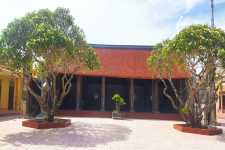
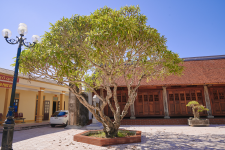
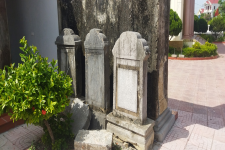
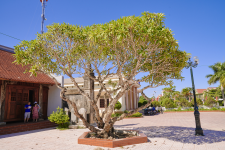
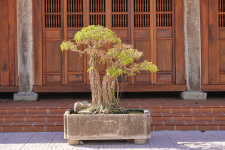
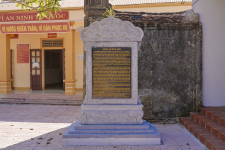

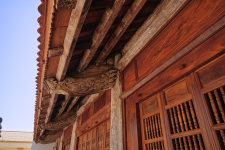
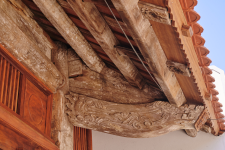
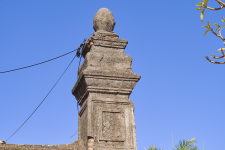
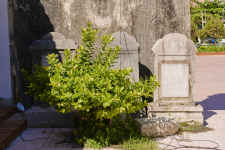
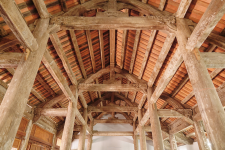
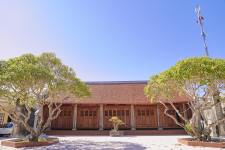
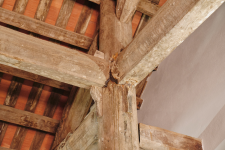
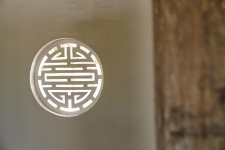
Camera tour
Price: Free
Time to visit a place: 120 phút
Open Time: 7:00 AM - Close Time: 6:00 PM
Address: Quynh Doi Village, Quynh Luu District, Nghe An Province
QUYNH DOI COMMUNAL HOUSE- QUYNH LUU
Quynh Doi Communal house is located in Quynh Doi commune, Quynh Luu district, Nghe An province. It was built during the reign of the Le Trung Hung to serve as a place for community cultural activities. The communal house was repaired and embellished many times, the largest scale was during the reign of King Tu Duc (1847 - 1883), with the contributions of many people, in which, the most prominent was the famous scholar Pham Dinh Toai.
The relic faces the south, located on a land famous for material works of artistic, cultural and historical value, rich in patriotic and revolutionary traditions. This is one of the ancient communal houses, with a large scale in Nghe An, with the architecture of 5 compartments, 2 gables, 6 sets of ironwood trusses, columns with height of 5.3m, 0.4m in diameter, dotted on the wooden structures are the motifs of the theme "dragon", "four seasons", adding the aesthetic value and majesty of the communal house. In front of the communal house, there are two stone steles that talk about the history of construction and restoration of the communal house.
This is the place where all the common activities of the whole village take place. Every year, people often organize festivals such as Ky Yen festival, Ky Phuc festival, etc quite solemnly, especially the ceremony to bring God from the God Temple to the communal house. After completing the traditional rituals, the villagers held funny games and sang very enthusiastically.
Quynh Doi Communal house is the place to mark many important historical events of the locality and the nation in the cause of defending the Fatherland. In particular, the communal house is associated with the Xo Viet Nghe Tinh movement (1930 - 1931), where the Party flags are hung, leaflets are distributed and drums are played to signal the compatriots, gathering the strength of the great unity of the whole people to fight, overthrow feudalism and minions, establishing the Soviet government – a revolutionary government imitating the great Russian October Revolution. The relic is also a testimony to denounce the crimes of the colonialists and feudalists. From January 1931, the French colonialists turned the communal house into a place of detention and torture of revolutionary activists. In February 1931, they shot 09 faithful communist soldiers in front of the communal house in order to terrorize, suppress and destroy the achievements of the revolutionary movement.
On August 15, 1945, thousands of people gathered at the communal house to participate in the robbery of the government. This is also the place to witness the handover of seals and papers of the old regime to the revolutionary government.
Currently, the communal house is being preserved and promoted by the government and people, and is a good symbol of generations of people in Quynh village. Quynh Doi Communal house was ranked as a national historical Site by the Ministry of Culture and Information according to Decision No. 2547/QD dated August 30, 1991.
Distance: 6.98 km
Distance: 7.24 km
Distance: 7.61 km
Distance: 7.77 km
Distance: 7.80 km
Distance: 8.87 km
Distance: 9.14 km
Distance: 11.66 km
Distance: 12.88 km
Distance: 2.85 km
Distance: 3.57 km
Distance: 3.81 km
Distance: 4.35 km
Distance: 6.14 km
Distance: 11.26 km
Distance: 11.28 km
Distance: 11.39 km
Distance: 11.93 km
Distance: 13.86 km
Distance: 13.92 km
Distance: 15.02 km
Distance: 15.30 km
Distance: 0 m
Distance: 330 m
Distance: 470 m
Distance: 920 m
Distance: 1.43 km
Distance: 6.15 km
Distance: 6.25 km
Distance: 6.63 km
Distance: 6.82 km
Distance: 6.92 km
Distance: 6.93 km
Distance: 6.95 km
Distance: 6.98 km
Distance: 7.29 km
Distance: 8.32 km
Distance: 8.70 km
Distance: 9.46 km
Distance: 10.93 km
Distance: 3.53 km
Distance: 4.25 km
Distance: 5.11 km
Distance: 5.21 km
Distance: 11.77 km
Distance: 12.73 km
Distance: 13.23 km


